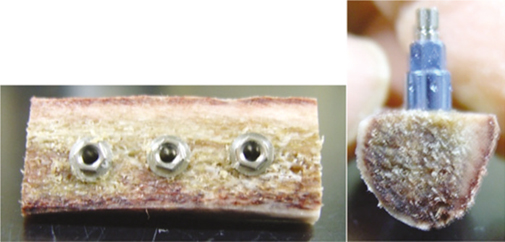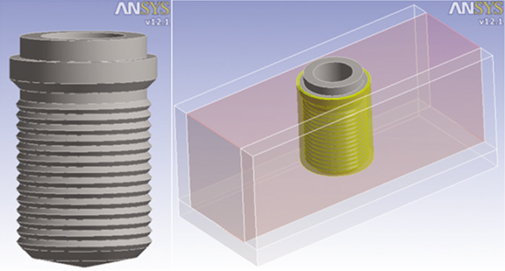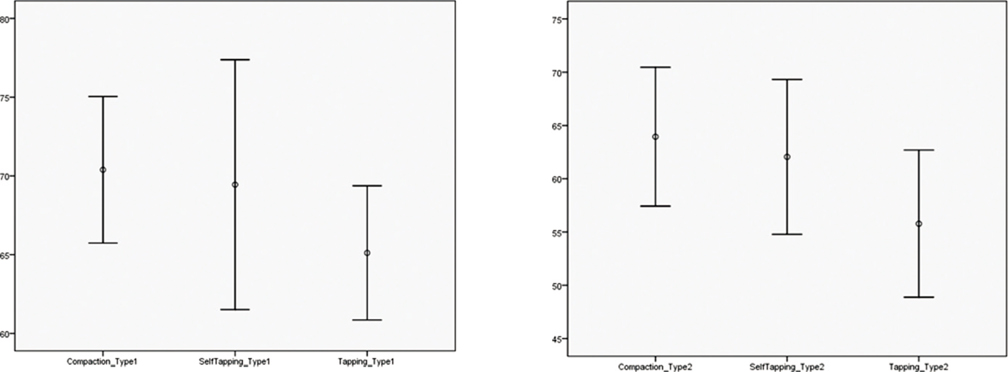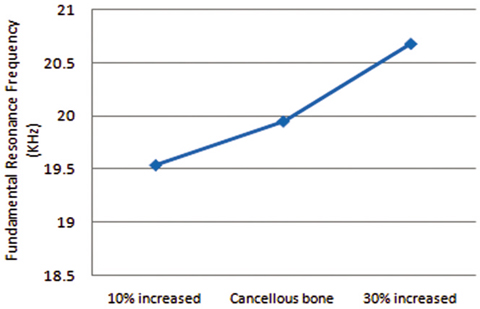J Adv Prosthodont.
2011 Mar;3(1):10-15. 10.4047/jap.2011.3.1.10.
Effect of bone quality and implant surgical technique on implant stability quotient (ISQ) value
- Affiliations
-
- 1Department of Dentistry, School of Dentistry, Seoul National University, Seoul, Korea.
- 2Department of Prosthodontics and Dental Research Institute, Seoul National University Dental Hospital, School of Dentistry, Seoul National University, Seoul, Korea. lsuyoung@hanmail.net
- KMID: 1975108
- DOI: http://doi.org/10.4047/jap.2011.3.1.10
Abstract
- PURPOSE
This study investigated the influence of bone quality and surgical technique on the implant stability quotient (ISQ) value. In addition, the influence of interfacial bone quality, directly surrounding the implant fixture, on the resonance frequency of the structure was also evaluated by the finite element analysis.
MATERIALS AND METHODS
Two different types of bone (type 1 and type 2) were extracted and trimmed from pig rib bone. In each type of bone, the same implants were installed in three different ways: (1) Compaction, (2) Self-tapping, and (3) Tapping. The ISQ value was measured and analyzed to evaluate the influence of bone quality and surgical technique on the implant primary stability. For finite element analysis, a three dimensional implant fixture-bone structure was designed and the fundamental resonance frequency of the structure was measured with three different density of interfacial bone surrounding the implant fixture.
RESULTS
In each group, the ISQ values were higher in type 1 bone than those in type 2 bone. Among three different insertion methods, the Tapping group showed the lowest ISQ value in both type 1 and type 2 bones. In both bone types, the Compaction groups showed slightly higher mean ISQ values than the Self-tapping groups, but the differences were not statistically significant. Increased interfacial bone density raised the resonance frequency value in the finite element analysis.
CONCLUSION
Both bone quality and surgical technique have influence on the implant primary stability, and resonance frequency has a positive relation with the density of implant fixture-surrounding bone.
Keyword
MeSH Terms
Figure
Reference
-
1. Meredith N. Assessment of implant stability as a prognostic determinant. Int J Prosthodont. 1998. 11:491–501.2. Lioubavina-Hack N, Lang NP, Karring T. Significance of primary stability for osseointegration of dental implants. Clin Oral Implants Res. 2006. 17:244–250.3. Sennerby L, Roos J. Surgical determinants of clinical success of osseointegrated oral implants: a review of the literature. Int J Prosthodont. 1998. 11:408–420.4. Su YY, Wilmes B, Hönscheid R, Drescher D. Application of a wireless resonance frequency transducer to assess primary stability of orthodontic mini-implants: an in vitro study in pig ilia. Int J Oral Maxillofac Implants. 2009. 24:647–654.5. Rodrigo D, Aracil L, Martin C, Sanz M. Diagnosis of implant stability and its impact on implant survival: a prospective case series study. Clin Oral Implants Res. 2010. 21:255–261.6. Zix J, Hug S, Kessler-Liechti G, Mericske-Stern R. Measurement of dental implant stability by resonance frequency analysis and damping capacity assessment: comparison of both techniques in a clinical trial. Int J Oral Maxillofac Implants. 2008. 23:525–530.7. Sim CP, Lang NP. Factors influencing resonance frequency analysis assessed by Osstell mentor during implant tissue integration: I. Instrument positioning, bone structure, implant length. Clin Oral Implants Res. 2010. 21:598–604.8. Sul YT, Jönsson J, Yoon GS, Johansson C. Resonance frequency measurements in vivo and related surface properties of magnesiumincorporated, micropatterned and magnesium-incorporated TiUnite, Osseotite, SLA and TiOblast implants. Clin Oral Implants Res. 2009. 20:1146–1155.9. Bilbao A, Oliveira MH, Varela-Centelles PI, Seoane J. Assessment of dental implant stability in osseodistraction-generated bone: a resonance frequency analysis. Clin Oral Implants Res. 2009. 20:772–777.10. Abrahamsson I, Linder E, Lang NP. Implant stability in relation to osseointegration: an experimental study in the Labrador dog. Clin Oral Implants Res. 2009. 20:313–318.11. Balshi SF, Wolfinger GJ, Balshi TJ. An examination of immediately loaded dental implant stability in the diabetic patient using resonance frequency analysis (RFA). Quintessence Int. 2007. 38:271–279.12. Deng B, Tan KB, Liu GR, Lu Y. Influence of osseointegration degree and pattern on resonance frequency in the assessment of dental implant stability using finite element analysis. Int J Oral Maxillofac Implants. 2008. 23:1082–1088.13. Chun HJ, Cheong SY, Han JH, Heo SJ, Chung JP, Rhyu IC, Choi YC, Baik HK, Ku Y, Kim MH. Evaluation of design parameters of osseointegrated dental implants using finite element analysis. J Oral Rehabil. 2002. 29:565–574.14. Lang LA, Kang B, Wang RF, Lang BR. Finite element analysis to determine implant preload. J Prosthet Dent. 2003. 90:539–546.15. Huang HM, Lee SY, Yeh CY, Lin CT. Resonance frequency assessment of dental implant stability with various bone qualities: a numerical approach. Clin Oral Implants Res. 2002. 13:65–74.16. Carter DR, Hayes WC. The compressive behavior of bone as a two-phase porous structure. J Bone Joint Surg Am. 1977. 59:954–962.17. Dechow PC, Nail GA, Schwartz-Dabney CL, Ashman RB. Elastic properties of human supraorbital and mandibular bone. Am J Phys Anthropol. 1993. 90:291–306.18. Schwartz-Dabney CL, Dechow PC. Accuracy of elastic property measurement in mandibular cortical bone is improved by using cylindrical specimens. J Biomech Eng. 2002. 124:714–723.19. Rozé J, Babu S, Saffarzadeh A, Gayet-Delacroix M, Hoornaert A, Layrolle P. Correlating implant stability to bone structure. Clin Oral Implants Res. 2009. 20:1140–1145.20. Piao CM, Heo SJ, Koak JY, Kim SK, Han CH, Fang XH. Effect of implant designs on insertion torque and implant stability quotient (ISQ) value. J Korean Acad Prosthodont. 2006. 44:325–332.21. Kim SK, Lee HN, Choi YC, Heo SJ, Lee CW, Choie MK. Effects of anodized oxidation or turned implants on bone healing after using conventional drilling or trabecular compaction technique: histomorphometric analysis and RFA. Clin Oral Implants Res. 2006. 17:644–650.22. Cehreli MC, Kökat AM, Comert A, Akkocaoğlu M, Tekdemir I, Akça K. Implant stability and bone density: assessment of correlation in fresh cadavers using conventional and osteotome implant sockets. Clin Oral Implants Res. 2009. 20:1163–1169.
- Full Text Links
- Actions
-
Cited
- CITED
-
- Close
- Share
- Similar articles
-
- The influence of implant diameter, length and design changes on implant stability quotient (ISQ) value in artificial bone
- Influence of implant fixture design on implant primary stability
- The effect of osteotome technique on primary implant stability according to implant fixture diameter
- The relationship between initial implant stability quotient values and bone-to-implant contact ratio in the rabbit tibia
- The effect of implant shape and bone preparation on primary stability






